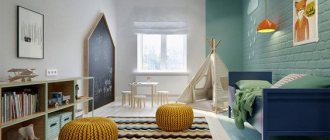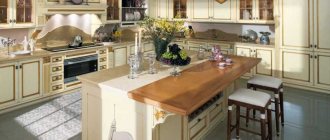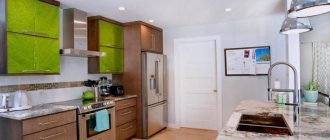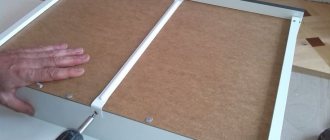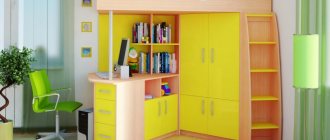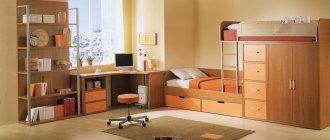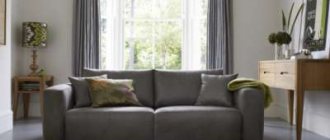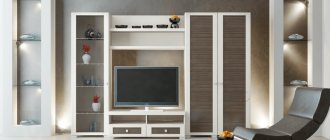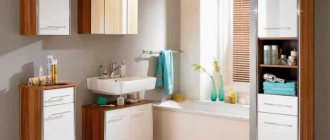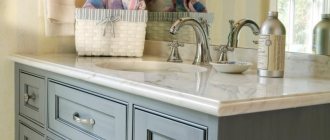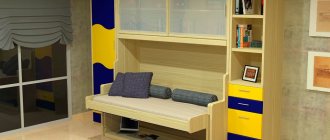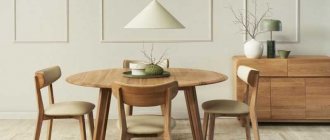What is cabinet furniture
The concepts of “cabinet” and “built-in” furniture. What applies to cabinet furniture? Types and designs of cabinet furniture. Modular furniture.
Definition of cabinet furniture.
We often come across offers from furniture companies and stores to purchase or order Cabinet Furniture.
But what is included in this concept, what can be called the term “cabinet furniture”? Let's figure it out. Cabinet furniture, according to the Big Encyclopedic Polytechnic Dictionary, is furniture that is completely or mainly a closed container (body), the main purpose of which is the storage and placement of various items.
The body is a rigid base. It consists of flat parts connected at right angles. In other words, if you see a furniture structure that resembles a parallelepiped, this is cabinet furniture.
Other furniture elements are attached to the body - sections, shelves, doors, guides, fittings, etc. This is the difference between cabinet and built-in furniture. In built-in furniture, there is no body and all internal elements are attached to the walls, floor and ceiling of the room in which this furniture is built.
What types of cabinet furniture are there and where are they used?
Cabinet furniture includes:
- cabinets, chests of drawers, chests,
- all types of wardrobes, including free-standing wardrobes,
- sideboards and display cabinets,
- secretaries and bureaus,
- various shelves and racks,
- desks and computer tables with flat sides,
- beds with backs and drawers in the form of planes,
- corner sofas with a rigid body, wide armrests, shelves and a built-in sleeping block.
Cabinet furniture is used wherever storage space is required, that is, in all rooms. This is furniture for the bedroom and nursery, office and living room, kitchen and dining room, bathroom and hallway.
What is cabinet furniture made of?
Cabinet furniture is made from materials with flat surfaces.
Laminated chipboard, MDF, plywood, blockboard or engineered board, solid wood in combination with glass, metal, and plastic make it possible to produce interior items in various styles. And modern manufacturers of furniture fittings and fixtures provide the opportunity to create high-tech designs.
Types of cabinet furniture by type of design.
Cabinet furniture is sectional furniture . It consists of sections and structural elements. Sections can be moved and combined with each other, which allows you to create various furniture items and designs.
Sectional furniture is divided into lockable, shelving and universally prefabricated.
Furniture that is assembled into blocks
Interlocking (or block) furniture consists of volumetric sections. Each section has a specific purpose and is equipped with all the necessary elements: shelves, drawers, doors, rods.
Lockable furniture includes cabinets for a specific purpose, pencil cases, hanging cabinets, display cabinets, mezzanines, shelves, chests of drawers, cabinets, etc.
Sections can be freely arranged in various combinations, placed in width and height, and can also be used as separate items.
Source: www.mdveri.com.ua
Manufacturers themselves classify furniture according to the following basic characteristics:
1) Depending on the materials used
According to the material of manufacture - chipboard (laminated chipboard), MDF, solid wood (wood panel) and various combined options.
2) By age orientation
Depending on the age orientation (furniture for children, teenagers, adults) - products whose shape, designs and sizes are designed for certain height and age characteristics of people.
3) By the nature of production
According to the nature of production, furniture is divided into:
- experimental production - this includes furniture manufactured in piece quantities (usually up to 10 copies) for exhibitions and artistic and design assessment (determining the manufacturability of production, for testing, analyzing consumer preferences, etc.);
- individual production - furniture made to order according to certain parameters;
- mass production – irregular production of template furniture in large quantities. Usually, after several releases, the series changes, but the saved equipment (templates, forms, calibers) allows production to be resumed if necessary;
- mass production – production designed for the continuous production of large batches of furniture according to a specific template over a long period of time.
4) According to production method
According to the production method, wooden furniture can be:
A) Bent - consists partially or completely of bent elements, which are assembled using metal fasteners (screws, bolts with nuts, wood grouse).
B) Wicker - made by various weaving of flexible wood (mainly from willow branches, bamboo, rattan).
C) Carpentry - furniture assembled from straight elements and parts of complex shapes, made on cutting machines using turning, milling, sawing. The connecting link is various fasteners and glue.
5) Design features
According to design and technological features:
A) collapsible - furniture, the design of which allows for repeated installation and disassembly;
B) non-separable – products with permanent connections;
C) sectional - structures consisting of two or more sections that can be combined, installed next to or on top of each other. This also includes furniture sections that are manufactured as a separate finished product, but can be used in whole or in part as part of a group combined into a block;
D) built-in furniture, the design feature of which is the absence of walls, sides, roof, bottom or all of the above (only sectional partitions, shelves and the front side are required);
E) transformable - furniture items made according to the “two in one” principle - sofa bed, chair bed, table, cabinet, etc.
6) Wooden furniture by destination
By destination - for indoor or outdoor use;
7) Completeness
By completeness:
- single piece of furniture;
- a group of individual products interconnected according to certain constructive, architectural and artistic principles, assembled into a set or set.
 Exploitation
Exploitation
According to operational purpose:
A) for home (household) - includes furniture for a common room, bedroom, bath, dining room, kitchen, office, hallway. This also includes furniture for a summer house and furnishings for a children's (teenage) room;
B) for public enterprises - educational organizations, trade, laboratory, industrial premises, catering, consumer services (including shops, pharmacies, hospitals, administrative premises, medical institutions, hotels, children's schools and preschool institutions, libraries, etc.) d.);
C) for transport - furniture intended for equipping various vehicles. A complete list of furniture broken down into categories and classified according to certain criteria can be found in GOST 20400-80 “Furniture production products. Terms and Definitions".
What is cabinet furniture
If we put aside upholstered furniture (everyone knows very well what it is), then furniture can be either cabinet-mounted or built-in. That is, cabinet furniture has back and side walls; it can be moved from place to place. Built-in furniture does not have such characteristics. Most often it takes the form of shelves built into stationary niches of partitions. This design is most often complemented by various convenient devices: boxes, rails, hooks, etc., which adapt to the needs of their owner. Thus, it cannot be moved entirely. Now let's look at modular designs.
What cabinet furniture is made of: materials
- Furniture board. Wood based sheets. Durable, resistant to external influences, practical material. Hypoallergenic, which means: cabinet furniture does not emit harmful substances during operation;
- Chipboard with veneer covering. It has an affordable price, durability, high performance characteristics;
- MDF. Medium density fiberboard, pressed under pressure. Durability, aesthetics;
- Solid wood. The most expensive version of the material, which has high environmental friendliness, quality and effectiveness.
What is modular furniture
Strictly speaking, modular furniture is a type of cabinet furniture. But if the second, often, is a kind of monolithic structure, then the first is more like a kind of construction set, the elements of which, maintained in the same color and style, can be swapped. Thus, you can literally trace the evolution of living room furniture: the Soviet standard walls, which occupied the lion's share of the room's space, were replaced by lighter and more modern sliding walls, and now progress has reached the point that this is not a wall at all, but a set of free items.
Standard housing was replaced by open-plan apartments and small studios, which began to dictate conditions for furniture manufacturers. A modern person does not want to see anything standard in his home; he wants to emphasize his individuality and completely customize the interior to suit his needs and interests. And modular furniture in this case is the optimal option.
Advantages of modular furniture
New and progressive is always better than proven, but outdated. Let's figure out why modular furniture is so good and try to find its flaws. Pros:
- From dozens of modules offered by the manufacturer, you can choose the ones you need. For example, for a large home library, you can allocate any number of cabinets, and those who like to put everything on shelves will need several cabinets with drawers.
- All items will fit perfectly together, forming a single style space. They can even stand on top of each other if necessary, and there is nothing to say about changing places - due to their lightness, they can be moved at least twice a day.
- Different widths, heights and depths of the modules allow you to play with space, choosing the most optimal arrangement for yourself. The room will not seem cluttered, there will be more air in it.
- For studio apartments, this option can be called the best: with a slight movement of the hand, the bedside table will turn into part of the hallway furniture, and the low TV stand will turn into a comfortable coffee table.
Types of cabinet furniture
Everyone has had to furnish an apartment with cabinet furniture at least once in their life. This is a pleasant, but troublesome business. Indeed, in combination with the style of the interior design, the issue of functionality of the furnishings is also resolved. The range of furniture products is huge. However, acquiring what you want is not easy, often due to a lack of knowledge. Information about the types of cabinet furniture will help a potential buyer make the right choice.
Walls, racks, cabinets, cabinets, tables not only create comfort in the house, but also perform utilitarian functions. The design of each item corresponds to its purpose. The assembly principle and materials are different. Furniture items are made in accordance with stylistic and functional requirements. Depending on these features, cabinet furniture is divided into types.
Features of choice
It’s not enough to just point to the photo you like and purchase a similar set. You need to approach the issue of choice wisely so that the purchased bed, wardrobe, chest of drawers ideally meets your requirements and the features of the room layout.
Cabinet products include everything except upholstered furniture. We offer you several basic recommendations that will help you make an informed purchase.
- Functionality. Some people put it in first place among the selection criteria, while others pay minimal attention to the issue of functionality. And the latter are wrong here. Practicality plays a huge role, because if the same closet is incredibly beautiful, but lacks the ability to accommodate all your things inside, you will have to look for separate places to store them. But a closet is just a closet to store clothes.
- Workmanship. We have already talked about materials, so be guided by them and your own wallet. Ask the store for documents, certificates, check the quality of not only the main materials, but also fasteners and hooks.
- Dimensions. The choice of the size of the housing elements depends on your needs. If you live alone and have few things, there is no point in buying huge wardrobes. For a large family, it is worth considering the option of large, roomy furniture.
- External characteristics. Having decided on the previous points, now choose based on external data. Just be sure to combine aesthetics with the selection criteria above.
Related article: How to impregnate wood with oil
Cabinet furniture is practical, multifunctional and beautiful. All that remains is to choose from the presented assortment, and if you cannot find the ideal option, create it yourself to order.
According to manufacturing technology
- Switchboard . It is made from wood-replacement panels and panels (plank, hollow and glued). The cost of the finished product is low due to inexpensive carpentry materials.
- Frame . The body is assembled from high-quality expensive frames and special inserts (panels), for which cheaper material is used. This type of furniture is the most common.
- From the array . Body made of solid wood (oak, hornbeam, walnut, pine, birch). Chipboard is used as standard for internal parts. It is considered an expensive piece of joinery.
By design
Depending on the design features, furniture is produced:
- Modular - with several independent sections (modules), with the help of which any structure can be assembled.
- Built-in – integrated into the walls (niches). Such furniture saves space, but when its location changes, the integrity of the objects or the unity of design is disrupted.
- Transformable - changing size and purpose when rearranging components. Furniture pieces make optimal use of space in a small apartment.
Posting rules
When arranging an apartment, office or private house, you need to plan the location of each modular element. This takes into account the shape and dimensions of the room. This is where the phrase “size matters” fits best. Modern cabinet furniture looks great in small apartments.
Corner cabinets made of acrylic glass are very popular today. Since glass is a fragile material, this type of furniture is recommended to be placed in a bedroom with large dimensions and preferably in light colors.
Some rules should be followed:
- In the library, it is advisable to place cabinet furniture in places with plenty of light;
- Corner cabinets are suitable for any interior. The cabinet design can be ordered according to an individual project or you can use ready-made offers in the retail chain;
- When arranging modular sections in a long room, it is not recommended to place them along the wall. And a square room is visually enlarged with an asymmetrical arrangement of furniture;
- The bedroom is a personal space that is conducive to relaxation. And a bedroom set can be installed in it;
- The children's room should be free. In a set of children's cabinet furniture, the bed should not take up much space, but should be comfortable. For small children, folding tables are recommended, which provide more space for games;
- Cabinet furniture for hotels should be comfortable with high performance qualities. For its production, chipboard, fiberboard, MDF and natural wood are used. All modules in one room must be combined and complement each other;
- The kitchen and bathroom are a special place in every home. Since they include communication systems and appliances, there are many options for modular kitchen units. They can be bought in a retail chain, or ordered according to an individual project, which, however, will cost much more than standard analogues.
By nature of application
Cabinet furniture is usually divided into universal, which is installed in any room and suits any interior, and special - only for specific rooms.
- For the living room . Sectional designs are popular. Furniture is arranged using modules. By combining parts that are similar in size and design in the living room interior, the desired composition is obtained.
- For the bedroom . A lot of furniture is allowed, but so as not to turn the sleeping area into a dressing room. For clothes and bed linen, it is enough to have cabinet cabinets, chests of drawers and a dressing table. The combination of these pieces of furniture makes the interior complete and harmonious, maintaining a feeling of comfort and intimacy.
- For children's . The main requirement for pieces of children's furniture is to solve functional problems without cluttering up the space. Maximum free space is achieved through non-standard design solutions. For example, beds are placed on the upper tier, and the lower part is equipped as a play area.
- For kitchen . This is a separate area in cabinet furniture with a huge range of functional and stylistic trends.
What should you pay attention to when choosing cabinet furniture?
So, when planning to purchase a set of cabinet furniture for your home, special attention should be paid to the following points:
- What materials were used in production. Not only the period of use of the furniture, but also its cost largely depends on this parameter. It is recommended to purchase furniture made from environmentally friendly materials, such as natural wood.
- Functionality. The furniture you choose should not only fit perfectly into the interior, but also be comfortable for everyday use. Therefore, if you choose, for example, a chest of drawers, you need to make sure that its drawers open easily.
- Type of fittings used. The durability of the furniture largely depends on the quality of the fittings used in production. Therefore, you should make sure that everything opens easily and simply, and there are no creaks or extraneous noises.
- Company manufacturer. It is important to understand that well-known companies will not skimp on the quality of materials in order to reduce the cost of their products. Therefore, if quality and reliability are your priority, you should consider cabinet furniture from trusted companies that have been supplying products to the market for many years.
By project type
Furniture makers divide cabinet furniture into three types:
- Headsets . The furniture set combines all the components. There is no need to select a wardrobe that would fit the bed, a chest of drawers to match the dressing table, etc. The combination of all components is thought out in advance. The style of furniture items and their color palette are consistent. The finished set is used to furnish the bedroom, living room, nursery, kitchen and other rooms. Designers recommend headsets if there are no changes to be made in the interior of the rooms in the coming years. A furniture set is purchased only after a complete renovation.
- Sectional systems . Furniture makers point out two important nuances of modular furniture: low cost with decent quality;
- the ability to vary the layout.
Features of the technological process for the production of cabinet furniture
There are several options for the technological process of manufacturing cabinet furniture. They can be divided into chains of different lengths:
- complete technological process - from the manufacture of material for the cabinet base (chipboard, MDF, furniture board) to the finished product. This is the best option for mass and serial production, allowing to significantly reduce the cost of materials, but very expensive from the point of view of small businesses;
- medium - furniture manufacturing, where the raw materials are ready-made sheets of chipboard, fiberboard, MDF - essentially, only cutting and assembly;
- short (assembly only) - the production of cabinet furniture is carried out from already cut to order chipboard, laminated chipboard, MDF. This is the most popular option for starting a small business from scratch, which involves working on a specific order without purchasing expensive cutting equipment. Then, after developing an appropriate customer base and receiving serial orders, you can think about purchasing your own cutting and edge banding machines in order to “lengthen” the technological process chain and expand production. This explains the relative ease of entering the furniture manufacturing business - in fact, it can be plan in any sequence of the production cycle.
The manufacturing technology of any cabinet furniture is divided into five main stages:
- Drawing up a project of the finished product in various planes;
- Cutting out the necessary materials for the parts of future furniture;
- Drilling sockets for fasteners;
- Finishing of cut edges (laminated edge, veneer, PVC film);
- Assembly of the finished product.
A detailed description of the technological process depends on the automation of production and the percentage of use of manual and mechanized labor. The most progressive (and, accordingly, expensive) production is considered to be one equipped with automated machines (CNC). The operator only needs to enter the dimensional data into a special computer program, design the desired product and give the “start” command.
In just a few minutes, a CNC machine will cut out the necessary walls and partitions of future cabinet furniture from clearly fixed materials, and drill holes according to the development plan. All that remains is to trim the edges and assemble the finished furniture. But it is profitable to buy such lines if there are constant serial orders. It makes no sense to reconfigure the machine for each piece of furniture on an individual order. Therefore, let us consider, as an example, the “golden mean” - the operation of a semi-automatic line of several machines with partial use of manual labor.
To start such production you will need the following equipment:
1. format-cutting machine with manual supply of materials;
2. edge banding machine for finishing straight edges, concave and convex elements;
3. drilling and filler machine for making blind and open holes for fittings, hinges, dowels;
4. grinding machine;
5. screwdrivers;
6. hammer drill;
7. cutting tools (mills, drills, knives).
Description of the production technology of cabinet furniture
1) After the sketch has been developed and approved by the customer, a model of the future product is created using a computer program that can be installed on a regular laptop.
For example:
- Cutting – a program for selecting the optimal cutting of chipboard, laminated chipboard, MDF sheets with the least loss;
- PRO 100 is a program for visualizing a model sketch in 3D, drawing up a design, constructing and calculating the necessary materials, parts and accessories for assembly.
But manufacturers of automatic and semi-automatic machines also offer other types of programs already installed on their equipment, for example “UCANCAM V9″, “ArtCAM”, etc.
2) The slab of material from which the product will be made is fixed on the machine and cut into individual parts in accordance with the cutting charts.
If furniture is made from fiberboard, this is where the preparatory work ends - the parts are sent for assembly. If we are talking about furniture made of chipboard or laminated chipboard, the rough blanks are subject to mandatory mechanical processing of the sawn edges;
3) Furniture parts made from chipboard are supplied to an edge banding machine, where, using glue and a pressure press, the board sections are lined with laminated edge , PVC film, melamine or other edge materials;
4) Depending on the configuration of the machine, holes for fasteners are made:
- semi-automatically - on additive machines;
- manually, using hammer drills and electric drills, using drawings with additive diagrams.
6) After adding holes, the product is ground along the edges (to smooth, remove overhangs of the edge material in height and length) and sent for assembly;
7) Control assembly using hand tools helps to identify defects and inconsistencies and eliminate them in the finished product. After which, the furniture is disassembled (if necessary), packaged and sent to the finished goods warehouse.
Cabinet furniture: types and features
Published: 05/23/2017,
Cabinet furniture is a huge segment that includes various furniture products. In this article we will tell you in more detail about the existing types of cabinet furniture, their purpose and features.
Cabinet furniture can be characterized as a stationary massive structure consisting of prefabricated elements. This category includes almost all the furniture around us: cabinets, racks, tables, shelves, etc. A variety of materials are used in production: from wood and chipboard to metal and plastic. There is a huge amount of cabinet furniture that differs in design and has a special purpose. Let's try to understand all this diversity and give a clear classification of cabinet furniture.
Materials
Most often, such models are made from laminated chipboards. Entirely wooden specimens are extremely rare and belong to elite goods. Sometimes natural wood and chipboard are combined, making only facades for cabinet furniture from solid wood.
How to choose luxury furniture and distinguish the original from the fake
Modern materials:
- The most popular is laminated particle board. High-quality chipboard products can last 10–15 years. At the same time, furniture made from them is not very heavy and can (within certain limits) withstand high humidity. The main advantage is the affordable cost.
- MDF furniture costs a little more, but the boards are stronger and more reliable. Unlike chipboard, the material allows for fine finishing (carving, inlay) and wide variations in shape.
- High-quality cabinet furniture is made from solid wood. Beech, pine, walnut, and hornbeam are suitable for this. Environmentally friendly and very attractive material. With proper care it will last for several generations. The disadvantages include the large weight of the products and the very high cost.
- For furniture in a modern style (high-tech, minimalism, modernism) glass, plastic, and metal are used. The materials can decorate a room for any purpose (office, residential building, public buildings). Disadvantages include the high cost of some designer models and high maintenance requirements. For example, scratches on glass or plastic cannot be masked, unlike wood.
Caring for cabinet furniture depends on the material it is made of. With the help of modern means, you can extend the service life and maintain the attractive appearance of products even at home.
For finishing facades, solid wood, wood boards, mirrors, plastic, metal, and rattan (rattan palm vine) are used. The choice of material depends on the purpose and style of the furniture. For example, a regular or corner wardrobe with mirrored doors would be suitable for a bedroom; for a kitchen it would be more practical to purchase plastic or laminated chipboard. Natural wood is more appropriate in a living room or office. A wide range of facades for cabinet furniture and corresponding photos will allow you to choose an option that suits your style, quality and budget.
Chipboard
MDF
Array
Glass, metal
Plastic
Rattan
Types of cabinet furniture
Let's start with the main distinguishing feature of this or that furniture product - design features. Each type of product can have a different design and materials, so it will not be difficult to choose the right model for any interior.
Cabinets
The most common representative of cabinet furniture. A closet is available in any apartment and is intended for storing clothes, shoes and other things. Models vary in size, capacity, opening method, design and material. In the classical sense, the word “wardrobe” refers to a standard wardrobe with hinged doors.
Walls
A more complex design is the furniture wall. The composition includes several autonomous elements that are located close to each other. The wall can consist of cabinets, racks and display cases that have different purposes, but are made in the same style. This type of furniture is multifunctional and versatile. The design can be linear, angular or U-shaped. Walls are more often used in interiors designed in a classic style. The cost is affected by the size, number of elements, as well as the chosen material and finishing method.
Showcases and slides
This type of furniture is a tall glass cabinet designed for storing dishes and other things that you want to display. Slides, as a rule, have only one glass, while showcases can be glazed on all four sides.
Buffet and sideboard
A sideboard is usually called a massive cabinet, more than 2 meters high. Usually it is divided into two parts: the lower one is made in the form of a cabinet with blind doors, and the upper one is a niche and several compartments equipped with glazing. The buffet is designed for storing plates, cups, cutlery, tablecloths, tea sets and other utensils. It can also store a variety of non-perishable foods. Usually made of wood or its analogues.
A sideboard is very similar to a buffet; it has the same purpose: storing and displaying dishes. The differences are in size, the sideboard is usually of medium height, wider and has more glazing. The lower part may have pull-out shelves, and the side part is often equipped with a bar to accommodate alcohol. This type of furniture was widely popular in the last century, but is now becoming less and less relevant.
Libraries and shelving
The library is a structure of several bookcases. They can cover an entire wall and have a sliding design that allows you to save space and conveniently place the entire collection of available literature. It is possible to equip it with lighting or sliding doors, similar to a wardrobe.
The shelves have a similar design, but they are less designed for storing books. This is a shelf system designed to accommodate absolutely any thing, from vases and figurines to household appliances and aquariums. Shelving often serves as decorative partitions, allowing you to divide the space of a room.
Hallway and dressing room
The hallway allows you to conveniently store outerwear, shoes, umbrellas, bags, etc. The design includes an open or closed niche equipped with a rod on which clothes are hung. At the bottom there are often pull-out shelves for shoes. For comfort, hallways are equipped with benches or ottomans, as well as mirrors. All elements of the composition have a common back wall.
Furniture classification
Furniture is classified according to the following main characteristics: operational, functional, structural and technological, by materials by production method as well as by .
Classification of furniture according to operational purpose
Household furniture is products intended for furnishing various rooms, apartments, cottages or outdoor use. There are the following types of household furniture for:
- common room (for rooms with combined functions, for example kitchen-dining room, bedroom-office);
- bedroom;
- dining room;
- living room;
- office;
- children's (products whose sizes, shapes and designs correspond to the age characteristics and growth characteristics of children);
- kitchens;
- hallways;
- bathrooms;
- dacha
Furniture for public premises is products intended for furnishing the premises of enterprises and institutions, taking into account the nature of their activities and the specifics of functional processes. The following types of such furniture are distinguished:
- medical (for hospitals, clinics and other medical institutions);
- laboratory (for laboratories, including educational and medical);
- for preschool institutions (kindergartens, nurseries);
- for educational institutions (schools, colleges, technical colleges and universities);
- for trade and catering establishments (canteens, restaurants, cafes, snack bars, etc.);
- for consumer services, hotels and health resorts, theatrical and entertainment institutions, libraries and reading rooms, sports facilities, administrative premises, waiting rooms of transport institutions, communications enterprises.
Furniture for transport is products designed to equip various means of transport.
Classification of furniture by functional purpose
Furniture for storage (cabinet) , the main purpose of which is the storage and placement of various items. The following products of this furniture are distinguished:
- cabinets for clothes, linen, dishes, books;
- kitchen cabinet is a product designed for storing kitchen and household items. It can be part of the working front of the kitchen or be a separate product;
- kitchen cabinet-table - a product intended for cooking and serving, with containers for storing kitchen utensils and food products;
- cabinet under the sink - designed for installing a sink;
- cabinet with display case (showcase) - a glazed piece of furniture designed for storing and displaying various items;
- cabinet-partition - a product designed to divide a room into separate zones;
- wall cabinet;
- multi-purpose cabinet - a product with compartments for various functional purposes;
- chest of drawers - a product with drawers for storing linen;
- toilet cabinet - a product with a mirror and containers for storing toiletries;
- low-height cabinet cabinet for various purposes;
- secretary - a product with a folding door or a retractable board intended for performing written work;
- sideboard cabinet - a product for storing dishes and table linen, the upper plane of which is used for serving work;
- chest - a piece of cabinet furniture with a folding or removable top lid, designed for storing various things;
- shelf - a product without a front wall, with or without a back wall, designed to accommodate books or other items.
Sitting and lying furniture is designed to accommodate a person in sitting and lying positions. The following items of such furniture are distinguished:
- bed - a product intended for sleeping, with a mattress, with one or two backrests;
- single bed - intended for one person;
- double bed - intended for two people;
- sofa - a combined product with a back, designed to seat several people;
- sofa bed - a sofa that can be transformed into a bed;
- couch - a product with or without a head back and headrest, intended for lying;
- ottoman - a wide couch with or without a longitudinal back, intended for lying;
- bench - a product with or without a back and armrests, with a seat height equal to or greater than its depth, intended for seating several people;
- stool - a product without a back and armrests, with a hard seat (or with a flooring), intended for sitting one person;
- banquette - a product without a back, with an upholstered seating surface, intended for one or several people;
- chair - a product with or without a back, armrests, with a seat height that is functionally comfortable in relation to the height of the table (dining table, desk), intended for sitting one person;
- chair - a comfortable piece of furniture with or without a back, armrests, intended for sitting one person;
- work chair (work chair) - a product with armrests, with a seat height equal to the height of the chair seat;
- lounge chair - a product with or without armrests, with a seat height less than the height of the chair seat;
- chair-bed is a product for relaxation, which in a transformed position can be used for lying;
- rocking chair;
- a chaise longue is a light chair designed for reclining, which can be transformed during use.
Based on the presence of a soft element , the amount of its deformation under load (depending on the type of base, elastic part and soft flooring), furniture is divided into:
1. Rigid furniture with elements without flooring or with flooring up to 10 mm thick; 2. Soft.
Furniture for work and dining - products intended for eating, performing various work and installing objects. Such furniture includes:
- table - a product with a working plane located at a functionally convenient height, intended for working, eating and installing various objects;
- dining table - a product intended for eating;
- serving table - a product designed for serving food and cleaning dishes;
- desk - a product intended for studying and performing written work;
- coffee table (pre-sofa) - a low table designed to form a seating area;
- dressing table - a product with a mirror and containers for storing toiletries.
